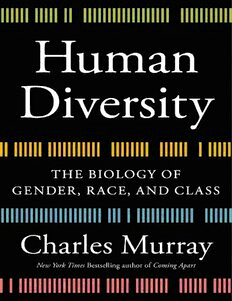
Charles Murray - Human Diversity Gender, Race, Class, and Genes PDF
Preview Charles Murray - Human Diversity Gender, Race, Class, and Genes
Copyright Copyright © 2020 by Cox and Murray, Inc. Cover design by Jarrod Taylor. Cover copyright © 2020 by Hachette Book Group, Inc. Hachette Book Group supports the right to free expression and the value of copyright. The purpose of copyright is to encourage writers and artists to produce the creative works that enrich our culture. The scanning, uploading, and distribution of this book without permission is a theft of the author’s intellectual property. If you would like permission to use material from the book (other than for review purposes), please contact [email protected]. Thank you for your support of the author’s rights. Twelve Hachette Book Group 1290 Avenue of the Americas, New York, NY 10104 twelvebooks.com twitter.com/twelvebooks First Edition: January 2020 Twelve is an imprint of Grand Central Publishing. The Twelve name and logo are trademarks of Hachette Book Group, Inc. The publisher is not responsible for websites (or their content) that are not owned by the publisher. The Hachette Speakers Bureau provides a wide range of authors for speaking events. To find out more, go to www.hachettespeakersbureau.com or call (866) 376-6591. Library of Congress Control Number: 2019952691 ISBNs: 978-1-5387-4401-7 (hardcover), 978-1-5387-4400-0 (ebook) E3-20191205-JV-NF-ORI Contents Cover Title Page Copyright Dedication Epigraph A Note on Presentation Introduction Part I “Gender Is a Social Construct” 1. A Framework for Thinking About Sex Differences 2. Sex Differences in Personality 3. Sex Differences in Neurocognitive Functioning 4. Sex Differences in Educational and Vocational Choices 5. Sex Differences in the Brain Part II “Race Is a Social Construct” 6. A Framework for Thinking About Race Differences 7. Genetic Distinctiveness Among Ancestral Populations 8. Evolution Since Humans Left Africa 9. The Landscape of Ancestral Population Differences Part III “Class Is a Function of Privilege” 10. A Framework for Thinking About Heritability and Class 11. The Ubiquity of Heritability and the Small Role of the Shared Environment 12. Abilities, Personality, and Success 13. Constraints and Potentials Part IV Looking Ahead 14. The Shape of the Revolution 15. Reflections and Speculations Acknowledgments Discover More About the Author Appendix 1: Statistics for People Who Are Sure They Can’t Learn Statistics Appendix 2: Sexual Dimorphism in Humans Appendix 3: Sex Differences in Brain Volumes and Variance Notes References To Harlan Crow Explore book giveaways, sneak peeks, deals, and more. Tap here to learn more. I remember once being entreated not to read a certain newspaper lest it might change my opinion upon free-trade. “Lest I might be entrapped by its fallacies and misstatements,” was the form of expression. “You are not,” my friend said, “a special student of political economy. You might, therefore, easily be deceived by fallacious arguments upon the subject. You might, then, if you read this paper, be led to believe in protection. But you admit that free-trade is the true doctrine; and you do not wish to believe what is not true.” —Charles Sanders Peirce “The Fixation of Belief,” 1877 A Note on Presentation Human Diversity is grounded in highly technical literatures involving genetics, neuroscience, and statistics. It must satisfy two audiences with completely different priorities: my intended reader and the experts. I’ve always thought of my intended reader as someone who enjoys reading the science section of the New York Times—curious about scientific matters, but someone who wants the gist of the science, not the minutiae. I need to keep the narrative moving. But I am conveying material that often has daunting technical complexities. Readers also need to be able to compare my claims with the details of the underlying evidence. I use my three favorite devices: Boxed text introduces related issues that are interesting but not essential. Appendixes provide full-scale discussions of important ancillary issues. Endnotes expand on points in the main text. But Human Diversity uses these devices, especially the endnotes, even more extensively than I have in the past. Some of the endnotes are full-scale essays, complete with tables. Brackets around a callout number for an endnote indicate that it contains at least a substantial paragraph of additional exposition. For this complicated book, I have had to add a fourth device. In the past, I have usually been able to avoid technical jargon in the main text. Human Diversity doesn’t give me that option. Too much material cannot be discussed without using technical terms that will be new to many readers. I therefore insert periodic interludes in the text to explain them. I have also tried to make the book more accessible by my
